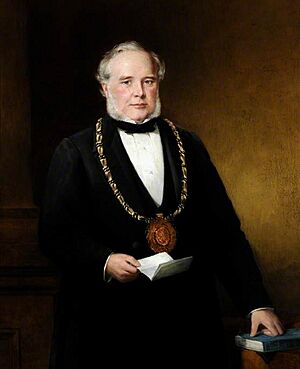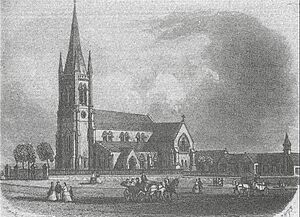John Brown (industrialist) facts for kids
Sir John Brown (born December 6, 1816 – died December 27, 1896) was a famous English businessman and inventor. He was born in Sheffield, a city known for its steel. People called him the "Father of the South Yorkshire Iron Trade" because he helped grow the iron industry there.
Contents
Early Life and Beginnings
John Brown was born in Sheffield on December 6, 1816. His father, Samuel Brown, worked as a slater, fixing roofs. John went to a small local school. At just 14 years old, he started working as an apprentice for a company called Earl, Horton, & Co.
This company made files and cutlery, like knives and forks. John later took over the part of the business that sold goods. He traveled around the country selling these products. In 1839, he married Mary Scholefield. They lived in Sheffield for most of their lives. John Brown passed away on December 27, 1896, in Bromley.
Building a Business
In 1844, John Brown started his own company, John Brown & Company. He began making steel at a small workshop in Sheffield. His business quickly became very successful. He sold his old selling business and moved to a bigger place on Furnival Street.
The Volute Spring Invention
In 1848, John Brown created an important invention. It was a special steel spring called a "conical steel spring buffer." This spring was used in railway carriages. It helped absorb shocks and make train rides smoother. He sold these springs to many railway companies across the UK.
The Atlas Works
On January 1, 1856, John Brown opened his new factory, the Atlas Works. He wanted to bring all his workshops and workers together in one large place. The factory started on about 3 acres of land in Brightside, South Yorkshire. Within three years, it grew to cover 30 acres!
By 1859, Brown was making rails for the fast-growing railway industry. He used a new method called the Bessemer process. This process made steel much faster and cheaper.
John Brown's biggest achievement was making armour plating for warships. In 1860, he saw a French ship called La Gloire. This ship was made of wood but covered with thick iron plates. This made the British government worried, so they decided to add armor to their own ships.
Brown believed he could roll these armor plates instead of hammering them. Rolling would make them stronger and more even. He was the mayor of Sheffield at the time. He invited the Prime Minister, Lord Palmerston, to see his new process. Later, in April 1863, naval leaders visited his factory. They watched as a huge plate, 12 inches thick and 15 to 20 feet long, was rolled.
The navy was very impressed. They ordered almost all the armor plates they needed from John Brown's Atlas Works. In just a few years, his company had provided armor for about three-quarters of the British navy.
His factory, the Atlas Works, grew to employ over 4,000 skilled workers. He made armor plates, parts for cannons, railway bars, steel springs, and train wheels. He also supplied iron for making steel in Sheffield. John Brown was the first to successfully use the Bessemer process and make steel rails in Sheffield.
He often received requests from other countries to buy his armor plates. However, he always refused these orders unless the British government approved. For example, during the American Civil War, he turned down large orders from the northern states.
Later Life and Retirement
In 1864, John Brown turned his business into a larger company that could be owned by many people (a limited liability company). He then retired to Endcliffe Hall, a grand house near Sheffield.
He was the Lord Mayor of Sheffield in 1862 and 1863. He was also the "master cutler" in 1865 and 1866, a special title for a leader in the Sheffield cutlery industry. In 1867, he was knighted, which means he was given the title "Sir."
In 1865, he had Endcliffe Hall built as his private home. It was, and still is, the largest private house ever built in Sheffield. Between 1866 and 1869, he paid for the building of All Saints Church in Brightside. This church was built to serve the many workers at his Atlas Ironworks.
Company Merger
In 1902, John Brown & Company joined forces with another Sheffield steelmaker, Thomas Firth & Sons. They exchanged shares and worked together. They kept their own names until 1930, when they officially merged to form Firth Brown Ltd.
See also
- John Brown & Company – In 1899, the company John Brown created bought a shipyard. It became one of the most famous shipbuilders of the 20th century.












